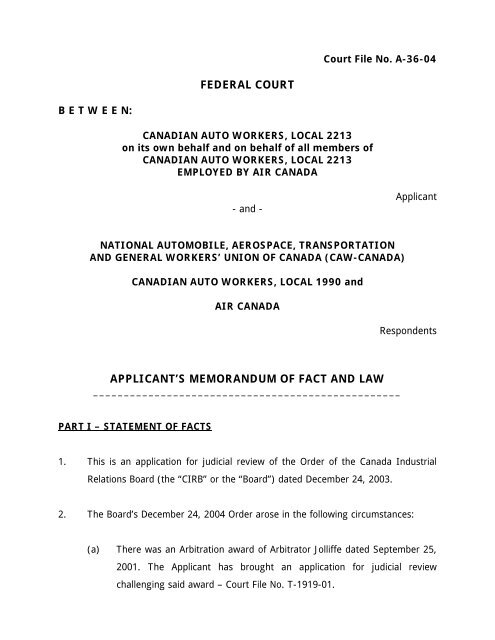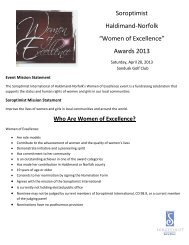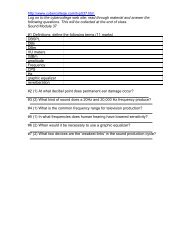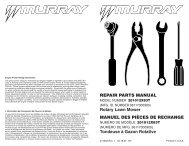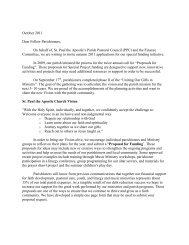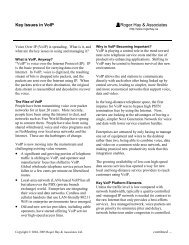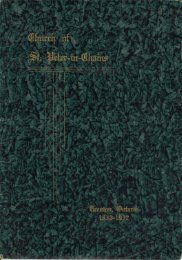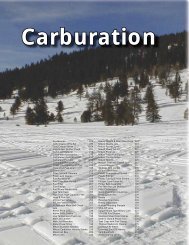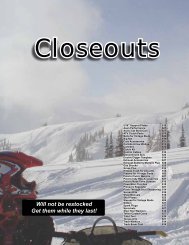federal court applicant's memorandum of fact and law
federal court applicant's memorandum of fact and law
federal court applicant's memorandum of fact and law
- No tags were found...
Create successful ePaper yourself
Turn your PDF publications into a flip-book with our unique Google optimized e-Paper software.
Court File No. A-36-04FEDERAL COURTB E T W E E N:CANADIAN AUTO WORKERS, LOCAL 2213on its own behalf <strong>and</strong> on behalf <strong>of</strong> all members <strong>of</strong>CANADIAN AUTO WORKERS, LOCAL 2213EMPLOYED BY AIR CANADA- <strong>and</strong> -ApplicantNATIONAL AUTOMOBILE, AEROSPACE, TRANSPORTATIONAND GENERAL WORKERS’ UNION OF CANADA (CAW-CANADA)CANADIAN AUTO WORKERS, LOCAL 1990 <strong>and</strong>AIR CANADARespondentsAPPLICANT’S MEMORANDUM OF FACT AND LAW__________________________________________________PART I – STATEMENT OF FACTS1. This is an application for judicial review <strong>of</strong> the Order <strong>of</strong> the Canada IndustrialRelations Board (the “CIRB” or the “Board”) dated December 24, 2003.2. The Board’s December 24, 2004 Order arose in the following circumstances:(a) There was an Arbitration award <strong>of</strong> Arbitrator Jolliffe dated September 25,2001. The Applicant has brought an application for judicial reviewchallenging said award – Court File No. T-1919-01.
2(b)By Order dated May 14, 2003, the CIRB incorporated the Arbitrator’saward as a decision <strong>of</strong> the Board. The Applicant has brought anapplication for judicial review challenging said Order – Court File No. A-261-03.(c)The Applicant filed an application for reconsideration, requesting that theCIRB reconsider <strong>and</strong> revoke its May 14, 2003 Order. In an Order datedDecember 24, 2003, the Board dismissed the Applicant’s application forreconsideration. The instant application deals with the Board’sDecember 24, 2003 Order.3. The Board sent a covering letter to the parties attaching a copy <strong>of</strong> the Board’sDecember 24, 2003 Order. The covering letter (also dated December 24, 2003),reads in part:“The Board’s Reasons for Decision will follow as soon as possible.”4. To date, the Board has not released any reasons for its December 24, 2003Order.5. The Applicant (“Local 2213”) was the trade union representing customer <strong>and</strong>sales <strong>and</strong> service agents at Air Canada prior to the merger.6. The Respondent, Canadian Auto Workers, Local 1990 (“Local 1990”) was thetrade union representing customer <strong>and</strong> sales <strong>and</strong> service agents, as well ascertain employees in cargo, load <strong>and</strong> baggage, at CAIL prior to the merger.7. On January 4, 2000, Air Canada purchased CAIL <strong>and</strong> thereafter merged the twooperations.
38. On September 22, 2000, the Canada Industrial Relations Board (the “CIRB”)issued a decision pursuant to Section 35 <strong>of</strong> the Canada Labour Code declaringthat Air Canada <strong>and</strong> CAIL are a single employer for purposes <strong>of</strong> the Code withrespect to customer <strong>and</strong> sales <strong>and</strong> service agents.9. In paragraph 132 <strong>of</strong> its September 22, 2000 decision, the CIRB stated that theprocess contemplated by Section 18.1(2) to (4) <strong>of</strong> the Code would be initiated.10. Section 18.1 <strong>of</strong> the Code empowers the CIRB to deal with various issues thatarise following a Section 35 declaration, including the power pursuant toSection 18.1(4) to:“…amend, to the extent the Board considers necessary, theprovisions <strong>of</strong> collective agreements respecting expiry dates orseniority rights, or amend other such provisions.”11. On January 28, 2001, Air Canada, Local 2213, Local 1990 <strong>and</strong> the CAW NationalUnion entered into a Protocol Agreement, referring the seniority issue to theArbitrator. The Protocol Agreement reads in part:“1. The parties to the Letter <strong>of</strong> Agreement dated the 28 th day <strong>of</strong>September, 2000, with respect to the seniority issuearbitration, agree that the arbitrator, Thomas Jolliffe, willhave all the same powers <strong>and</strong> jurisdiction provided underthe Canada Labour Code as would the CIRB if it werehearing the matter.2. The parties also agree that the Award <strong>of</strong> the arbitrator willbe incorporated into an Order <strong>of</strong> the CIRB under Section18.1 <strong>of</strong> the Code <strong>and</strong> shall be final <strong>and</strong> binding on theparties <strong>and</strong> the employees in the bargaining unit. Any partyretains any right it has to seek judicial review <strong>of</strong> the Award<strong>and</strong>/or Order.….5. The above mentioned Letter <strong>of</strong> Agreement <strong>and</strong> this ProtocolAgreement will be incorporated into an Order <strong>of</strong> the CIRB tobe issued pursuant to Section 18.1(2)(b) <strong>of</strong> the Code.”
412. It should be noted that in a decision dated January 24, 2001, the CIRB roughlydetermined the new sales <strong>and</strong> service bargaining unit at Air Canada. The cargo,load <strong>and</strong> baggage group <strong>of</strong> employees who had been part <strong>of</strong> Local 1990’sbargaining unit at CAIL were placed into the new sales bargaining unit but thecargo, load <strong>and</strong> baggage functions were given to another bargaining unitrepresented by another trade union – the International Association <strong>of</strong> Machinists(“IAM”) – who had always represented this group at Air Canada. Theapproximately 600 Local 1990 members performing these functions at CAILeffectively had their jobs eliminated, <strong>and</strong> were transferred into the new sales <strong>and</strong>service bargaining unit at Air Canada.13. At the arbitration before the Arbitrator, the position <strong>of</strong> the parties may besummarized as follows:(a)Local 2213’s position was that the service <strong>of</strong> all employees in thecombined bargaining unit should be recognized for service-based benefitsunder the collective agreement (such as vacation entitlement). However,with respect to seniority (which determined such matters as workschedules, work location <strong>and</strong> lay<strong>of</strong>fs), Local 2213’s position was that theseniority <strong>of</strong> Local 1990’s members should be “endtailed” after the seniority<strong>of</strong> Local 2213’s members. Alternatively, Local 2213 argued that seniority inthe combined unit should be integrated on a ratio basis, based on theamount <strong>of</strong> work or jobs CAIL <strong>and</strong> Local 1990 were bringing to the mergedoperations. Local 2213 proposed a ratio <strong>of</strong> 5:1 but indicated the Arbitratormight consider a different ratio as appropriate. Finally, <strong>and</strong> at the veryleast, Local 2213 argued that the seniority <strong>of</strong> the Local 1990 memberswho had worked in cargo, load <strong>and</strong> baggage positions <strong>and</strong> otheremployees (which were not part <strong>of</strong> the combined unit) should have theirseniority endtailed.
5(b)Local 1990’s position was that the seniority <strong>of</strong> its members at CAIL <strong>and</strong>the seniority <strong>of</strong> Local 2213 members under its Air Canada collectiveagreement should both be recognized in the combined bargaining unit; inother words, the new seniority list should be “dovetailed”.(c)Air Canada remained neutral <strong>and</strong> took no position regarding thecompeting seniority integration arguments at the arbitration.14. Local 2213 relied upon various <strong>fact</strong>s <strong>and</strong> arguments in support <strong>of</strong> its position.15. Firstly, Local 2213 relied upon the terms <strong>of</strong> its collective agreement with AirCanada defining seniority. Article 10.01 <strong>of</strong> said collective agreement reads:“Seniority shall be established by classification on a system basiswithin Canada <strong>and</strong> shall date from an employee’s permanent entryinto a classification covered by this agreement. Employeespermanently reclassified within the agreement shall take theirseniority with them to their new classification.”16. Under the Local 2213/Air Canada collective agreement, seniority was onlyrecognized as <strong>of</strong> the date an employee first became employed in a classificationcovered by the collective agreement. Even employees who had worked for AirCanada in any other position not covered by the agreement did not have suchprior service recognized for seniority purposes. In other words, the history <strong>and</strong>practice <strong>of</strong> Air Canada <strong>and</strong> Local 2213 had always been to endtail seniority.17. Local 2213 also pointed out that Local 1990 members had been able toaccumulate seniority under the terms <strong>of</strong> its collective agreement with CAIL incircumstances not available to Local 2213 members under the Air Canadaagreement.
618. Local 2213 also relied upon the economic <strong>fact</strong>s leading up to the merger <strong>of</strong> AirCanada <strong>and</strong> CAIL in support <strong>of</strong> its contention that its members should not bedisadvantaged – with respect to seniority <strong>and</strong> its consequences – as a result <strong>of</strong>the merger.19. CAIL was in serious financial difficulties when it was purchased by Air Canada.CAIL’s serious financial position was recognized by the Alberta Queen’s Bench inRe Canadian Airlines Corp., [2000] A.J. No. 771.20. CAIL had been suffering financial losses since at least 1991. From 1988 until1999, CAIL had lost $1.8 billion. CAIL had to seek concessions from itsemployees in 1994 <strong>and</strong> 1996. In 1999, the year before the merger, CAIL lost$222 million. The estimated value <strong>of</strong> CAIL as a st<strong>and</strong> alone business at the time<strong>of</strong> the merger ranged from a negative $1.1 billion to a negative $22 million.21. On the other h<strong>and</strong>, Air Canada had been making a pr<strong>of</strong>it since 1994. Between1994 <strong>and</strong> the merger in 2000, Air Canada recorded pr<strong>of</strong>its totalling almost $1billion. In 1999, Air Canada had a pr<strong>of</strong>it <strong>of</strong> $213 million.22. CAIL had maintained high staffing level, notwithst<strong>and</strong>ing its precarious financialposition <strong>and</strong> had agreed to no lay<strong>of</strong>fs. The ratio <strong>of</strong> employees per aircraft at CAILwas 170.23. Air Canada, despite its superior financial position, maintained lower staffinglevels <strong>and</strong> had cut nearly 4,900 jobs overall in a four (4) year period, includingjobs in customer <strong>and</strong> sales. The ratio <strong>of</strong> employees per aircraft at Air Canada was145.24. Local 2213 also noted that Local 1990 members had greatly benefited from themerger, irrespective <strong>of</strong> the seniority integration issues. The merger saved Local1990 members’ jobs; they received a no-lay<strong>of</strong>f guarantee for four (4) years; they
7received a substantial wage increase (bringing them parity with the Local 2213Air Canada members) <strong>and</strong> pension improvements.25. In his September 25, 2001 Decision, the Arbitrator decided to dovetail seniority(with the possible exception <strong>of</strong> Winnipeg airport). The Arbitrator held that therewas an “industry norm <strong>of</strong> dovetailing the seniority <strong>of</strong> sales <strong>and</strong> service agentsfrom merging airlines in Canada”. The Arbitrator also held that dovetailing <strong>of</strong>seniority is “presumptively fair”.26. The Arbitrator stated that his determination should not be based upon a financialanalysis <strong>of</strong> the separate worth <strong>of</strong> the incoming airline business’ contribution tothe new Air Canada or the projected worth <strong>of</strong> the combined entity.27. Pursuant to the terms <strong>of</strong> the Protocol Agreement, on May 14, 2003, the CIRBincorporated the Arbitrator’s award as an Order <strong>of</strong> the Board.28. The Arbitrator did not decide any date when the seniority lists should be merged.29. There were other seniority integration arbitration awards dealing with othergroups <strong>of</strong> employees at Air Canada. One <strong>of</strong> these other arbitration awards wasthe decision <strong>of</strong> Arbitrator Mitchnick dated March 31, 2001 dealing with the pilotgroup, which Arbitrator Jolliffe referred to in his Decision.30. The Mitchnick award dealing with pilots was subsequently reconsidered by theCIRB in a decision dated July 10, 2002 – CIRB Decision No. 183. An applicationfor judicial review <strong>of</strong> said decision was dismissed by the Federal Court <strong>of</strong> Appealin Reasons for Judgment delivered March 27, 2003.31. In CIRB Decision No. 183, the CIRB enunciated certain principles for theguidance <strong>of</strong> parties involved in seniority integration. These are:
8(a)In a process pursuant to the provisions <strong>of</strong> the Code, the bargaining rights<strong>of</strong> employees must be abridged only to the extent necessary in thecircumstances. The bargaining agents must live with the bargains thatwere struck <strong>and</strong> the matter must be decided upon the basis <strong>of</strong> thecollective agreement rights <strong>of</strong> each unit as <strong>of</strong> the time that these rightsare effectively merged (paragraph 138).(b)There should be no winners <strong>and</strong> no losers, or all should gain, <strong>and</strong>collective agreement rights must be effectively recognized <strong>and</strong> continued,if possible (paragraph 139).(c)Each situation must turn on the <strong>fact</strong>s relevant to it <strong>and</strong> the integration <strong>of</strong>seniority lists should be fair <strong>and</strong> equitable (paragraph 139).(d)A year <strong>of</strong> service is not necessarily to be treated as a year <strong>of</strong> service <strong>and</strong>given that what is most relevant is the level <strong>of</strong> benefits given to anemployee by their position relative to other employees length <strong>of</strong> service isonly one <strong>fact</strong>or <strong>of</strong> many that are reflected in an employee’s position(paragraph 141).(e)Any arbitration under the Code, unless the affected employees otherwiseagree, should seek to preserve the relative value <strong>of</strong> the benefits <strong>of</strong> theemployees, because their work position reflects the trade-<strong>of</strong>fs <strong>and</strong> choiceswhich they may have already made respecting location, education,training, the choice to work for one employer or another <strong>and</strong> the manyother <strong>fact</strong>s that have resulted in that work position (paragraph 141).(f)Date <strong>of</strong> hire does not make a fair adjustment for the demographic <strong>and</strong>other circumstances <strong>of</strong> the merger (paragraph 141).
9(g)There should be no windfall gain <strong>and</strong> corresponding arbitrary loss for theaffected employees. Where employees have attained a certain level orposition, the integration <strong>of</strong> the seniority lists must strive to protect this<strong>and</strong> should not be an occasion for one group <strong>of</strong> employees to improvetheir situation at the expense <strong>of</strong> another group (paragraph 142).(h)A realistic view must be taken <strong>of</strong> the value <strong>of</strong> benefits <strong>and</strong> collectiveagreement rights <strong>of</strong> each group <strong>and</strong> undue speculation forward <strong>and</strong>backward can lead to unjust results (paragraph 143).(i)The benefits which each group possesses at the relevant time <strong>and</strong> theirjob rights should be fairly assessed in their context <strong>and</strong> such benefits <strong>and</strong>rights, so far as possible, should be preserved to the affected employees(paragraph 143).(j)Where employment privileges are accessible based upon competitiveseniority, absolute seniority has no intrinsic value; rather, it is theemployee’s relative seniority that has meaning <strong>and</strong> allows that employeeto bid against those in the pool – as a result <strong>of</strong> this a fair method <strong>of</strong>integration to reflect the present circumstances should be one thatpreserves an employee’s absolute or relative seniority such that he cancontinue to have access to the job situation <strong>and</strong> privileges due to his level<strong>of</strong> seniority prior to the merger (paragraph 146).(k)A straightforward date <strong>of</strong> hire integration would see a substantive number<strong>of</strong> Canadian pilots significantly improving their pre-merger job status tothe disadvantage <strong>of</strong> the Air Canada pilots (paragraph 148).32. In paragraph 170 <strong>of</strong> Decision No. 183, the CIRB summarized the application <strong>of</strong>the above to the principles in a seniority integration <strong>of</strong> the Pilots under the Codeas follows:
10(a)the seniority lists should be merged as <strong>of</strong> October 17, 2002, the date atwhich the Board order merging the two bargaining units was issued;(b)the integration should take place upon the basis <strong>of</strong> the <strong>fact</strong>s, including jobsituations, aircraft actually working <strong>and</strong> collective agreement <strong>and</strong> seniorityrights, as <strong>of</strong> that date;(c)as far as is possible, the existing job situations <strong>and</strong> collective agreementseniority rights <strong>of</strong> those affected as <strong>of</strong> the merger <strong>of</strong> the units, should bepreserved <strong>and</strong> any changes in such rights should be restricted to theminimum necessary to effect the integration <strong>of</strong> the seniority list, if actions<strong>of</strong> the employer in the post-application, pre-October 17 period, were tothe significant disadvantage <strong>of</strong> either group, this can be considered;(d)to this effect, the merged seniority list should anticipate that the mergerhaving occurred, all bargaining unit members must anticipate thatwhatever occurs in the future will occur equally to all members <strong>of</strong> thebargaining unit in accordance with common rules, <strong>and</strong> that unlessabsolutely necessary to produce a fair result, the applicable seniority listshould not discriminate against identifiable groups <strong>of</strong> employees based ontheir prior affiliation;(e)on the basis <strong>of</strong> the evidence before Arbitrator Mitchnick <strong>and</strong> thisreconsideration panel, a date <strong>of</strong> hire seniority integration is notappropriate <strong>and</strong> the seniority list should be integrated on a ratio basis,treating those in defined similar categories similarly;(f)there should, on the basis <strong>of</strong> the evidence before the Board <strong>and</strong> as agreedon by the parties, be no adjustment in the relative seniority <strong>of</strong> employeeson either <strong>of</strong> the prior lists;
11(g)it will be necessary to examine seniority lists in detail to identify thespecific points <strong>of</strong> division or categories to be utilized <strong>and</strong> the ratios to beapplied. However, the focus in doing so, rather than being one <strong>of</strong>discounting should be to group pilots in a similar work situation togetherwith those who seniority allowed them to fly similar equipment withsimilar status at the relevant time being grouped together.33. As noted earlier, the Federal Court <strong>of</strong> Appeal dismissed an application for judicialreview seeking to quash CIRB Decision No. 183.34. After the CIRB incorporated the Arbitrator’s award as its Order dated May 14,2003 in the instant matter, the Applicant applied to the Board forreconsideration. The Applicant raised many <strong>of</strong> the arguments as will beaddressed below in this Memor<strong>and</strong>um, including that the Arbitrator’s award (<strong>and</strong>hence the Board’s Order) is inconsistent with <strong>and</strong> contrary to the principles theBoard referred to in its CIRB Decision No. 183 - the Board’s decision on anapplication for reconsideration in the pilots’ case.35. The Board held hearings with respect to the Applicant’s reconsideration requeston August 25 <strong>and</strong> 26, 2004. The Applicant argued that Arbitrator Jolliffe had notidentified any date to integrate seniority. This was clearly inconsistent with theBoard’s own decision in the pilot’s reconsideration case – CIRB December No.183. In Decision No. 183, the Board emphasized the importance <strong>of</strong> fixing a datefor seniority integration purposes in order to assess the impact <strong>of</strong> any proposedintegration.36. The CIRB issued an Order dated December 24, 2003, dismissing the Applicant’sapplication for reconsideration, without reasons. The instant application isseeking review <strong>of</strong> the CIRB’s December 24, 2003 Order.
1340. Pursuant to paragraph 2 <strong>of</strong> the Protocol Agreement, the award <strong>of</strong> the Arbitratorwas incorporated as an Order <strong>of</strong> the CIRB, which is dated May 14, 2003.41. The Applicant filed an application for reconsideration <strong>of</strong> the Board’s May 14, 2003decision. It is the Board’s Order dated December 24, 2003, dismissing saidapplication without reasons, which is the subject matter <strong>of</strong> the instantapplication.42. In the Protocol Agreement, the parties expressly agreed (in paragraph 2) that“any party retains any right it has to seek judicial review <strong>of</strong> the Award <strong>and</strong>/orOrder”.43. The Courts have held that a functional <strong>and</strong> pragmatic approach should befollowed in determining the appropriate st<strong>and</strong>ard <strong>of</strong> judicial review <strong>of</strong> decisions<strong>of</strong> administrative tribunals. The various <strong>fact</strong>ors to be considered are:(a)(b)(c)(d)the existence <strong>and</strong> wording <strong>of</strong> a privative clause;the relative expertise <strong>of</strong> the decision-makers;the purpose <strong>of</strong> the Act as a whole <strong>and</strong> the relevant provision inparticular; <strong>and</strong>the nature <strong>of</strong> the problem to be decided.Re Pushpanathan <strong>and</strong> Ministry <strong>of</strong> Citizenship <strong>and</strong> Immigration, (1998) 160D.L.R. (4 th ) 193 (S.C.C.)Canadian Union <strong>of</strong> Public Employees, Local 79 v. City <strong>of</strong> Toronto et al.,(2004) 232 D.L.R. (4 th ) 385 (S.C.C.) upholding the Ontario C.A. (2001)205 D.L.R. (4 th ) 280Toronto (City) Board <strong>of</strong> Education v. O.S.S.T.F., District 15, (1997) 144D.L.R. (4 th ) 385 (S.C.C.)United Brotherhood <strong>of</strong> Carpenters <strong>and</strong> Joiners <strong>of</strong> America, Local 579 v.Bradco Construction Ltd., (1993) 102 D.L.R. (4 th ) 402 (S.C.C.)
14London Life Insurance Co. v. Dubreuil Brothers Employees Association, aDivision <strong>of</strong> I.W.A. Canada Local 2693 et al., (2000) 190 D.L.R. (4 th ) 428(Ontario C.A.)Re Trent University Faculty Association <strong>and</strong> Board <strong>of</strong> Governors <strong>of</strong> TrentUniversity, (1997) 150 D.L.R. (4 th ) 1 (Ontario C.A.)Re Ontario English Catholic Teachers’ Association <strong>and</strong> Lanark, Leeds <strong>and</strong>Grenville County Roman Catholic Separate School Board, (1996) 136D.L.R. (4 th ) 660 (Ontario C.A.)44. In the instant case, it is not clear if the privative clauses contained in the CanadaLabour Code apply to the arbitration pursuant to the Protocol Agreement, laterincorporated as an Order <strong>of</strong> the Board.45. However, it is submitted that the other <strong>fact</strong>ors to be considered support theconclusion that the Arbitrator’s award (<strong>and</strong> the Board’s refusal to reconsider saidaward) under review ought to be subject to a correctness st<strong>and</strong>ard.46. There is no suggestion Arbitration Jolliffe had any experience dealing withseniority integration under the Canada Labour Code.47. As an Arbitrator, Mr. Jolliffe has no experience or expertise in interpreting <strong>and</strong>applying any <strong>of</strong> the provisions <strong>of</strong> the Canada Labour Code let alone Sections 35<strong>and</strong> 18.1(2) to 4.48. The nature <strong>of</strong> the problem to be decided arises under a statutory scheme.49. For these reasons, it is submitted that the appropriate st<strong>and</strong>ard <strong>of</strong> review is that<strong>of</strong> correctness.50. Alternatively, we submit the st<strong>and</strong>ard is that <strong>of</strong> patent unreasonableness.
1551. The Supreme Court <strong>of</strong> Canada has described the patently unreasonable test inthe context <strong>of</strong> an application for judicial review <strong>of</strong> an arbitrator’s decision asfollows:“The inquiry therefore focuses on whether the Board applied thewrong principles or applied the correct principles in the wrong way,for example, by making an award which is not supported by theevidence or by reason”Per Cory <strong>and</strong> McLachlin JJ. In paragraph 69Retail, Wholesale <strong>and</strong> Department Store Union, Local 454 et al. v.Canada Safeway Ltd., (1998) 160 D.L.R. (4 th ) 1 (S.C.C.)52. It is our submission that under either st<strong>and</strong>ard, the Arbitrator’s award <strong>and</strong> theBoard’s Order refusing to reconsider said award ought to be quashed.(ii)Whether the Arbitrator <strong>and</strong> the Board erred in failing to determine anydate when the seniority lists should be merged53. In CIRB Decision No. 183, the CIRB emphasized the importance <strong>of</strong> determiningthe date when seniority lists should be merged. This is one <strong>of</strong> the issues theFederal Court <strong>of</strong> Appeal dealt with in the judicial review <strong>of</strong> that decision.54. In the instant case, the Arbitrator made no determination as to the date whenthe seniority lists ought to be integrated. It is submitted that the Arbitratorthereby erred. The Board declined to reconsider the Arbitrator’s decision,notwithst<strong>and</strong>ing it is clearly inconsistent with its own Decision No. 183.55. It is our position that the appropriate date for merging <strong>of</strong> the seniority lists <strong>of</strong>Locals 1990 <strong>and</strong> 2213 is September 26, 2002. This is the date when the CIRBissued an order merging the customer sales <strong>and</strong> service agents’ bargaining units.September 26, 2002 would be the date consistent with the pilots’ case.
1656. Alternatively, January 24, 2001 is the appropriate date. That is the date whenthe CIRB issued its decision to merge the new customer sales <strong>and</strong> service agents’bargaining unit.(iii) Whether the Arbitrator <strong>and</strong> the Board erred by failing to ensure thatthe impact <strong>of</strong> the award was consistent with the principles <strong>of</strong> the Code57. In CIRB Decision No. 183, the CIRB revoked <strong>and</strong> set aside the Mitchnickarbitration award dealing with the pilots’ group on the basis that the arbitratorfailed to ensure that his award was consistent with the principles <strong>of</strong> the Code.The CIRB in Decision No. 183 enunciated a number <strong>of</strong> principles which ought tobe applied in seniority integration – we summarized these principles earlier inparagraphs 28 <strong>and</strong> 29 <strong>of</strong> this Memor<strong>and</strong>um.58. It is submitted that the Arbitrator’s Decision in the instant case must beconsidered in light <strong>of</strong> the principles set out in CIRB Decision No. 183.59. It is respectfully submitted that Arbitrator Jolliffe neither referred to nor appliedmost, if not all <strong>of</strong> these principles. The Arbitrator simply based his decision ontwo (2) points: his conclusion that dovetailing was the “industry norm” <strong>and</strong> thatdovetailing was “presumptively fair”.60. Neither <strong>of</strong> these two (2) points is referred to by the CIRB in Decision No. 183.Nowhere in CIRB Decision No. 183 does the CIRB state that consideration <strong>of</strong>industry norms is a relevant, let alone a determining <strong>fact</strong>or. Neither does theCIRB refer to or adopt Arbitrator Jolliffe’s principle that dovetailing <strong>of</strong> seniority is“presumptively fair”.61. In reaching his Decision, the Arbitrator relied upon the report <strong>of</strong> one <strong>of</strong> Local1990’s experts, Tom Walker, to conclude that dovetailing the seniority lists wasappropriate. According to Mr. Walker, dovetailing would benefit Local 1990
17members by plus 2.3 percent <strong>and</strong> disadvantage Local 2213 members by negative2.2 percent.62. Firstly, it is submitted that even based on these figures, the Decision dovetailingseniority creates “winners <strong>and</strong> losers”.63. In terms <strong>of</strong> individuals, this represents an average loss <strong>of</strong> 171 positions for aLocal 2213 member <strong>and</strong> an average gain <strong>of</strong> 179 positions for a Local 1990member equaling a differential <strong>of</strong> 350 positions between the members <strong>of</strong> the twolocals on a system-wide basis. This calculation is based on the combined totalamount <strong>of</strong> 7,777 agents (the number <strong>of</strong> agents from both locals on January 4,2000) <strong>and</strong> using the average loss <strong>of</strong> 2.2% for Local 2213 <strong>and</strong> the average gain<strong>of</strong> 2.3% for Local 1990 (with a differential <strong>of</strong> 4.5%).64. Secondly, Mr. Walker’s analysis was based on a list <strong>of</strong> employees as <strong>of</strong>January 3, 2000 which, in our submission, is clearly an incorrect date <strong>and</strong>provides a skewed view <strong>of</strong> the “winners <strong>and</strong> losers”.65. Accordingly, the effect <strong>of</strong> the Arbitrator’s decision to dovetail will have asignificant negative impact on Local 2213 members <strong>and</strong> their expectations thatwill last a working lifetime. The Board has refused to reconsider the Arbitrator’sdecision. On this point alone, it is our respectful submission that the Arbitratorhas erred grievously <strong>and</strong> his decision ought to be quashed.(iv)Whether the Arbitrator <strong>and</strong> the Board erred by failing to consider <strong>and</strong>apply the provisions <strong>of</strong> Section 18.1(4)(d) <strong>of</strong> the Code66. Section 18.1(4)(d) <strong>of</strong> the Canada Labour Code empowers the CIRB to:“…amend, to the extent that the Board considers necessary, theprovisions <strong>of</strong> collective agreements respecting expiry dates orseniority rights, or amend other such provisions.”
1867. Local 2213 argued before Arbitrator Jolliffe that his jurisdiction was limited bySection 18.1 <strong>of</strong> the Code <strong>and</strong> in particular Section 18.1(4)(d). Local 2213addressed the meaning <strong>of</strong> Section 18.1(4)(d) <strong>and</strong> consequently the test thatarose from that provision. Local 1990 made no submissions on the meaning <strong>of</strong>the Code or the proper test to be applied.68. At no point in the reasons for decision does the Arbitrator delineate the testbeing applied in conjunction with an interpretation <strong>of</strong> the Code. In <strong>fact</strong>, what testthe Arbitrator applied is unclear from the decision <strong>and</strong> cannot be found anywherein the Code. It was not a test <strong>of</strong> necessity, as provided for in Section 18.1(4)(d)<strong>of</strong> the Code.69. As stated by the Board in CIRB Decision No. 183, Sections 35 <strong>and</strong> 18.1 <strong>of</strong> theCode are clearly related <strong>and</strong> should be read together. The purpose <strong>of</strong> theseprovisions is to protect bargaining <strong>and</strong> bargained rights. Accordingly, negotiatedcollective agreement rights must be protected <strong>and</strong> the collective agreementshould only be amended “to the extent that the Board considers necessary”.70. The evidence before Arbitrator Jolliffe was that the collective agreement betweenCAIL <strong>and</strong> Local 1990 would be repealed <strong>and</strong> replaced with the collectiveagreement between Air Canada <strong>and</strong> Local 2213 with certain exceptions.Accordingly, at the time the Board has determined that the seniority list shouldbe merged – in the case <strong>of</strong> the Customer Sales <strong>and</strong> Service Agents,September 26, 2002 or in the alternative January 24, 2001 – the relevantprovisions <strong>of</strong> the collective agreements applicable to both Locals 2213 <strong>and</strong> 1990was the Air Canada Local 2213 collective agreement. Article 10.01 <strong>of</strong> saidcollective agreement reads:“Seniority shall be established by classification on a system basiswithin Canada <strong>and</strong> shall date from an employee’s permanent entryinto a classification covered by this Agreement. Employees
19permanently reclassified within the Agreement shall take theseniority with them to their new classification.”71. The evidence before the Arbitrator with respect to the “history” <strong>of</strong> Local 2213members employed as Customer Sales <strong>and</strong> Service Agents at Air Canada wasone <strong>of</strong> endtailing. The uncontradicted evidence before the Arbitrator was thatwhenever any employee became employed in a position covered by the Local2213/Air Canada collective agreement, regardless <strong>of</strong> what bargaining unit oremployer they had come from, they were always endtailed. This is true forindividuals coming from other bargaining units within Air Canada (includingbargaining units for which Local 2213 held bargaining rights) or whether thoseemployees came from other employers for which Local 2213 held bargainingrights (such as Air BC). Moreover, this occurred in spite <strong>of</strong> the <strong>fact</strong> that in manycircumstances such employees brought their own as well as the potential foradditional work <strong>and</strong>/or jobs with them.72. This is overwhelming evidence <strong>of</strong> employees’ expectations <strong>and</strong> the manner inwhich the seniority provisions <strong>of</strong> the Air Canada <strong>and</strong> Local 2213 collectiveagreement operated.73. Notwithst<strong>and</strong>ing this evidence, the Arbitrator’s Decision has rendered this articlecompletely meaningless as Local 2213 demonstrated repeated examples <strong>of</strong> waysin which Local 1990 members accrued seniority outside <strong>of</strong> the Customer Sales<strong>and</strong> Service Classification/Bargaining Unit while Local 2213 members did not.This practice continues to this day as former Local 1990 members from the CrewScheduling bargaining unit continue to accrue seniority within the SalesBargaining Unit even though they are two distinct bargaining units <strong>and</strong> theCustomer Sales <strong>and</strong> Service bargaining unit members <strong>of</strong> Local 2213 never agreedto allow this patently unfair practice <strong>of</strong> double accrual to exist.
2074. By ignoring this Article <strong>and</strong> the test to be applied pursuant to Section 18.1(4)(d)<strong>of</strong> the Code, it is submitted that the Arbitrator violated the principles enunciatedby the CIRB in CIRB Decision No. 183. Specifically, Arbitrator Jolliffe failed to:! Properly consider the preservation <strong>of</strong> existing job situations, collectiveagreement <strong>and</strong> seniority rights;! Restrict changes to the collective agreement to the minimumnecessary in order to effect the integration <strong>of</strong> the seniority lists;! Merge the seniority lists with as little effect as possible upon bargained<strong>and</strong> existing rights;! Treat bargaining unit members equally.75. The other particularly relevant article is Article 18.05 which the Arbitrator quotedinaccurately in his award. Article 18.05 provides as follows:“In the event that the Company changes ownership, mergers withanother company or in way changes its corporate identity, thisagreement will remain in full force <strong>and</strong> effect <strong>and</strong> the unionrecognition now in effect <strong>and</strong>/or the certificate issued by theCanada Labour Relations Board then in existence shall not beaffected in any way except as otherwise governed or directed bythe Board. The company further agrees to enter into negotiationswith the union relative to protection <strong>of</strong> employee seniority <strong>and</strong>other conditions <strong>of</strong> this agreement. Failing settlement theprovisions <strong>of</strong> the Canada labour Code will apply.”76. The evidence before the Arbitrator was that the former collective agreementapplicable to members <strong>of</strong> Local 1990 contained no such provision, nor did thecollective agreements <strong>of</strong> the Customer Sales <strong>and</strong> Service Agents employed by thevarious airlines that over time formed CAIL. The Arbitrator failed to consider orproperly consider these two articles from the collective agreement. TheArbitrator, therefore, violated the test <strong>of</strong> necessity as contained inSection 18.1(4)(d) <strong>of</strong> the Code <strong>and</strong> also violated the principles enunciated by theBoard in that the purpose <strong>of</strong> Section 35 is to protect bargained rights; negotiated
21collective agreement rights must protected. Not only were the rights created bythese articles ignored by the Arbitrator, they were not in any way, shape or formprotected.77. The Board’s refusal to reconsider the Arbitrator’s award is totally inconsistentwith the principles it enunciated in its Decision No. 183.(v)Whether the Arbitrator <strong>and</strong> the Board erred in the interpretation <strong>and</strong>application <strong>of</strong> the principles applicable to seniority integration78. As noted, the Arbitrator did not apply the principles enunciated by the CIRB inCIRB Decision No. 183. Rather, the Arbitrator relies upon two (2) basic premises:“industry norm” <strong>and</strong> his view that dovetailing is “presumptively fair”. Neither <strong>of</strong>these points is recognized by the CIRB in its Decision No. 183 as being relevant,let alone determinative.79. The correctness (or alternatively, the reasonableness) <strong>of</strong> the Arbitrator’s Decisioncan be assessed by comparing <strong>and</strong> contrasting it with the seniority integrationarbitration decisions involving other groups <strong>of</strong> the employees at Air Canada.80. In the Pilots’ case, after CIRB Decision No. 183 reconsidered ArbitratorMitchnick’s award, the seniority integration issue was referred to a differentarbitrator – a board chaired by Arbitrator Keller. This resulted in an award datedJune 16, 2003. The Keller award does not adopt dovetailing <strong>of</strong> seniority.81. Arbitrator Adams dealt with seniority integration in the bargaining unitrepresented by the International Association <strong>of</strong> Machinists. In the Adams awarddated November 5, 2001, seniority is not dovetailed.82. Arbitrator Burkett dealt with seniority integration <strong>of</strong> two (2) groups <strong>of</strong> employeesrepresented by CUPE Airline Division. In three (3) awards – dated November 28,
222001, April 26, 2002 <strong>and</strong> March 31, 2003 – Arbitrator Burkett does not dovetailseniority lists.83. It is submitted that Arbitrator Jolliffe erred in his interpretation <strong>and</strong> application <strong>of</strong>principles applicable to seniority integration <strong>and</strong> his Decision ought to bequashed.84. At the very least, it is submitted that the Arbitrator’s decision to dovetail theseniority <strong>of</strong> Local 1990 members previously employed in cargo <strong>and</strong> baggage atCAIL – jobs not included in the merged unit at Air Canada – is patentlyunreasonable.85. Again, we submit that the Board’s refusal to reconsider the Arbitrator’s decisioncan only be characterized as patently unreasonable, in all the circumstances.PART IV – ORDER SOUGHT86. The Applicant requests that the Board’s Order dated December 24, 2003 refusingto reconsider its earlier May 14, 2003 Order incorporating the Arbitrator’s award<strong>of</strong> September 25, 2001 be quashed; that the dispute be remitted to a differentarbitrator; <strong>and</strong> that the Responding Parties pay the costs <strong>of</strong> the Applicant.ALL OF WHICH IS RESPECTFULLY SUBMITTED.___________________________Douglas J. Wray, counsel for theApplicant
23PART V – LIST OF AUTHORITIESRe Pushpanathan <strong>and</strong> Ministry <strong>of</strong> Citizenship <strong>and</strong> Immigration, (1998) 160D.L.R. (4 th ) 193 (S.C.C.)Canadian Union <strong>of</strong> Public Employees, Local 79 v. City <strong>of</strong> Toronto et al.,(2004) 232 D.L.R. (4 th ) 385 (S.C.C.) upholding the Ontario C.A. (2001)205 D.L.R. (4 th ) 280Toronto (City) Board <strong>of</strong> Education v. O.S.S.T.F., District 15, (1997) 144D.L.R. (4 th ) 385 (S.C.C.)United Brotherhood <strong>of</strong> Carpenters <strong>and</strong> Joiners <strong>of</strong> America, Local 579 v.Bradco Construction Ltd., (1993) 102 D.L.R. (4 th ) 402 (S.C.C.)London Life Insurance Co. v. Dubreuil Brothers Employees Association, aDivision <strong>of</strong> I.W.A. Canada Local 2693 et al., (2000) 190 D.L.R. (4 th ) 428(Ontario C.A.)Re Trent University Faculty Association <strong>and</strong> Board <strong>of</strong> Governors <strong>of</strong> TrentUniversity, (1997) 150 D.L.R. (4 th ) 1 (Ontario C.A.)Re Ontario English Catholic Teachers’ Association <strong>and</strong> Lanark, Leeds <strong>and</strong>Grenville County Roman Catholic Separate School Board, (1996) 136D.L.R. (4 th ) 660 (Ontario C.A.)Retail, Wholesale <strong>and</strong> Department Store Union, Local 454 et al. v. CanadaSafeway Ltd., (1998) 160 D.L.R. (4 th ) 1 (S.C.C.)Air Canada, 2002 (CIRB Decision No. 183 dated July 10, 2002)Air Canada Pilots Association (unreported decision <strong>of</strong> the Federal Court <strong>of</strong>Appeal dated March 27, 2003)Air Canada Pilots’ Association v. Air Line Pilots’ Association v. Air Canada(Award <strong>of</strong> Arbitrator B. Keller dated June 16, 2003)IAM v. Air Canada (Award <strong>of</strong> Arbitrator G. Adams dated November 5,2001)CUPE Airline Division v. Air Canada (Award <strong>of</strong> Arbitrator K. Burkett datedNovember 28, 2001)CUPE Airline Division v. Air Canada (In-Charge Award <strong>of</strong> ArbitratorK. Burkett dated April 26, 2002)
24CUPE Airline Division v. Air Canada (Second In-Charge Award <strong>of</strong> ArbitratorK. Burkett dated March 21, 2003)
25APPENDIX “A”STATUTORY PROVISIONSCanada Labour Code, R.S.C. 1985, c.L-2, as amended:35. (1) Where, on application by an affected trade union or employer,associated or related <strong>federal</strong> works, undertakings or businesses are, in theopinion <strong>of</strong> the Board, operated by two or more employers having commoncontrol or direction, the Board may, by order, declare that for all purposes<strong>of</strong> this Part the employers <strong>and</strong> the <strong>federal</strong> works, undertakings <strong>and</strong>businesses operated by them that are specified in the order are,respectively, a single employer <strong>and</strong> a single <strong>federal</strong> work, undertaking orbusiness. Before making such a declaration, the Board must give theaffected employers <strong>and</strong> trade unions the opportunity to makerepresentations.(2) The Board may, in making a declaration under subsection (1),determine whether the employees affected constitute one or more unitsappropriate for collective bargaining.18.1 (1) On application by the employer or a bargaining agent, theBoard may review the structure <strong>of</strong> the bargaining units if it is satisfied thatthe bargaining units are no longer appropriate for collective bargaining.(2) If the Board reviews, pursuant to subsection (1) or section 35 or 45,the structure <strong>of</strong> the bargaining units, the Board(a) must allow the parties to come to an agreement, within aperiod that the Board considers reasonable, with respect to thedetermination <strong>of</strong> bargaining units <strong>and</strong> any questions arising fromthe review; <strong>and</strong>(b) may make any orders it considers appropriate to implementany agreement.(3) If the Board is <strong>of</strong> the opinion that the agreement reached by theparties would not lead to the creation <strong>of</strong> units appropriate for collectivebargaining or if the parties do not agree on certain issues within theperiod that the Board considers reasonable, the Board determines anyquestion that arises <strong>and</strong> makes any orders it considers appropriate in thecircumstances.(4) For the purposes <strong>of</strong> subsection (3), the Board may
26(a) determine which trade union shall be the bargaining agent forthe employees in each bargaining unit that results from the review;(b) amend any certification order or description <strong>of</strong> a bargainingunit contained in any collective agreement;(c) if more than one collective agreement applies to employees ina bargaining unit, decide which collective agreement is in force;(d) amend, to the extent that the Board considers necessary, theprovisions <strong>of</strong> collective agreements respecting expiry dates orseniority rights, or amend other such provisions;(e) if the conditions <strong>of</strong> paragraphs 89(1)(a) to (d) have been metwith respect to some <strong>of</strong> the employees in a bargaining unit, decidewhich terms <strong>and</strong> conditions <strong>of</strong> employment apply to thoseemployees until the time that a collective agreement becomesapplicable to the unit or the conditions <strong>of</strong> those paragraphs are metwith respect to the unit; <strong>and</strong>(f) authorize a party to a collective agreement to give notice tobargain collectively.
27APPENDIX BBOOK OF AUTHORITIES(to be filed separately)


